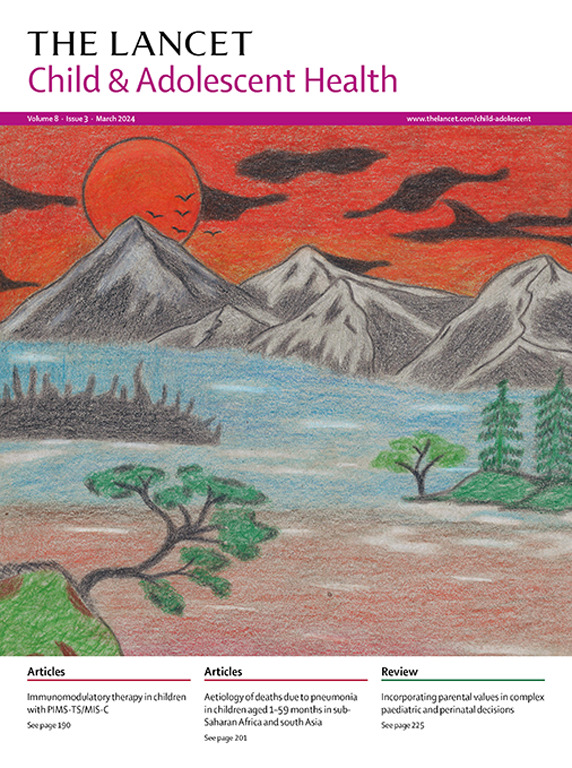All-cause mortality and infection-related outcomes of hospital-initiated kangaroo care versus conventional neonatal care for low-birthweight infants: a systematic review and meta-analysis
IF 15.5
1区 医学
Q1 PEDIATRICS
引用次数: 0
Abstract
Background
Kangaroo care has a well-established role in preterm infant stabilisation and in protecting low-birthweight newborns from mortality. Yet kangaroo care is far from fully embedded in conventional inpatient neonatal care practice. The evidence on infection outcomes of hospital-initiated kangaroo care is unclear. We aimed to evaluate the existing evidence to understand the role of hospital-initiated kangaroo care in preventing mortality, sepsis, and invasive infection in low-birthweight infants.
Methods
In this systematic review and meta-analysis, we searched Embase, MEDLINE, Cochrane Library, and Web of Science databases for literature published between Jan 1, 2013, and Feb 26, 2025. At least two authors independently undertook study selection, data extraction, and quality assessment. Reports of randomised controlled trials presenting data on at least one of our set primary outcomes (all-cause mortality and/or sepsis and/or invasive infection) comparing kangaroo care with conventional neonatal care in low-birthweight infants (<2500 g) were eligible for inclusion. The primary outcomes were all-cause mortality, sepsis, and invasive infection (composite of necrotising enterocolitis, pneumonia, meningitis, and other severe infections). Hypothermia and apnoea were assessed as adverse events. A random effects model was used to estimate the pooled overall effect sizes for each outcome, presented as odds ratios (OR [95% CI]), with between-study heterogeneity assessed by Cochran's Q test and sources of heterogeneity investigated using univariable random effects meta-regression analyses. This study is registered with PROSPERO, CRD42024501546.
Findings
We synthesised data from 29 studies, mainly from lower-middle income countries, including 17 513 low-birthweight infants. Most studies were moderate-to-high quality. 25 (86%) of 29 studies reporting all-cause mortality were included in the meta-analysis of hospital-initiated kangaroo care, which showed that hospital-initiated kangaroo care reduced all-cause mortality (pooled OR 0·77 [95% CI 0·67–0·89]; high-quality evidence, with I2=0%). 17 (59%) of 29 trials reported sepsis as an outcome, and the pooled results showed that kangaroo care reduced the odds of sepsis (OR 0·55 [95% CI 0·37–0·82]; moderate-quality evidence, with I2 =53%). Similarly, among the 11 (38%) of 29 studies reporting invasive infection, the pooled results showed that kangaroo care reduced the odds of invasive infection (OR 0·49 [95% CI 0·33–0·74]; moderate-quality evidence, with I2 =0%). Kangaroo care was associated with a significant reduction in the odds of sepsis-related or invasive infection-related mortality (OR 0·63 [95% CI 0·47–0·84], I2 =0%, high-quality evidence), hypothermia (0·28 [0·16–0·46], I2 =72%, moderate-quality evidence), and apnoea (0·46 [0·25–0·85], I2 =45%, moderate-quality evidence). Meta-regression showed that between-study heterogeneity was due to variation in level of kangaroo care offered as part of conventional neonatal care.
Interpretation
The joint protective effect of hospital-initiated kangaroo care against all-cause mortality and infection in low-birthweight infants reinforces its importance in routine neonatal care across settings, in line with WHO recommendations. The extent of the protective effects in low-birthweight infants through averted infections suggests that kangaroo care should be integrated into standard infection prevention and control practice globally.
Funding
European Society for Paediatric Infectious Diseases, the EU, and the Machaon Foundation.
低出生体重儿医院发起的袋鼠式护理与传统新生儿护理的全因死亡率和感染相关结果:系统回顾和荟萃分析
背景:袋鼠式护理在早产儿稳定和保护低出生体重新生儿免于死亡方面具有良好的作用。然而,袋鼠式护理还远远没有完全融入传统的新生儿住院护理实践。关于医院发起的袋鼠式护理的感染结果的证据尚不清楚。我们旨在评估现有证据,以了解医院发起的袋鼠式护理在预防低出生体重婴儿死亡率、败血症和侵袭性感染方面的作用。方法:在这项系统评价和荟萃分析中,我们检索了Embase、MEDLINE、Cochrane Library和Web of Science数据库,检索了2013年1月1日至2025年2月26日之间发表的文献。至少有两位作者独立进行了研究选择、数据提取和质量评估。对低出生体重儿进行袋鼠式护理与常规新生儿护理的随机对照试验报告,其数据至少符合我们设定的一组主要结局(全因死亡率和/或败血症和/或侵袭性感染)(研究结果:我们综合了29项研究的数据,主要来自中低收入国家,包括17513名低出生体重儿)。大多数研究都是中等到高质量的。29项报告全因死亡率的研究中有25项(86%)被纳入医院发起的袋鼠式护理的荟萃分析,结果显示医院发起的袋鼠式护理降低了全因死亡率(合并OR为0.77 [95% CI 0.67 - 0.89];高质量证据,I2=0%)。29项试验中有17项(59%)报告败血症为结果,综合结果显示袋鼠式护理降低了败血症的发生率(OR 0.55 [95% CI 0.37 - 0.82];中等质量证据,I2 =53%)。同样,在报告侵袭性感染的29项研究中的11项(38%)中,汇总结果显示袋鼠式护理降低了侵袭性感染的几率(OR 0.49 [95% CI 0.33 - 0.74];中等质量证据,I2 =0%)。袋鼠式护理与败血症相关或侵袭性感染相关死亡率的显著降低相关(or 0.63 [95% CI 0.47 - 0.84], I2 =0%,高质量证据)、体温过低(or 0.28 [0.16 - 0.46], I2 =72%,中等质量证据)和呼吸暂停(or 0.46 [0.25 - 0.85], I2 =45%,中等质量证据)。荟萃回归显示,研究间的异质性是由于袋鼠式护理水平的差异,袋鼠式护理是传统新生儿护理的一部分。解释:根据世卫组织的建议,医院发起的袋鼠式护理对低出生体重婴儿全因死亡率和感染的联合保护作用加强了其在各种情况下的常规新生儿护理中的重要性。通过避免感染对低出生体重婴儿产生保护作用的程度表明,袋鼠式护理应纳入全球标准的感染预防和控制实践。资助:欧洲儿科传染病学会、欧盟和Machaon基金会。
本文章由计算机程序翻译,如有差异,请以英文原文为准。
求助全文
约1分钟内获得全文
求助全文
来源期刊

Lancet Child & Adolescent Health
Psychology-Developmental and Educational Psychology
CiteScore
40.90
自引率
0.80%
发文量
381
期刊介绍:
The Lancet Child & Adolescent Health, an independent journal with a global perspective and strong clinical focus, presents influential original research, authoritative reviews, and insightful opinion pieces to promote the health of children from fetal development through young adulthood.
This journal invite submissions that will directly impact clinical practice or child health across the disciplines of general paediatrics, adolescent medicine, or child development, and across all paediatric subspecialties including (but not limited to) allergy and immunology, cardiology, critical care, endocrinology, fetal and neonatal medicine, gastroenterology, haematology, hepatology and nutrition, infectious diseases, neurology, oncology, psychiatry, respiratory medicine, and surgery.
Content includes articles, reviews, viewpoints, clinical pictures, comments, and correspondence, along with series and commissions aimed at driving positive change in clinical practice and health policy in child and adolescent health.
 求助内容:
求助内容: 应助结果提醒方式:
应助结果提醒方式:


